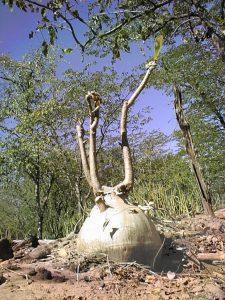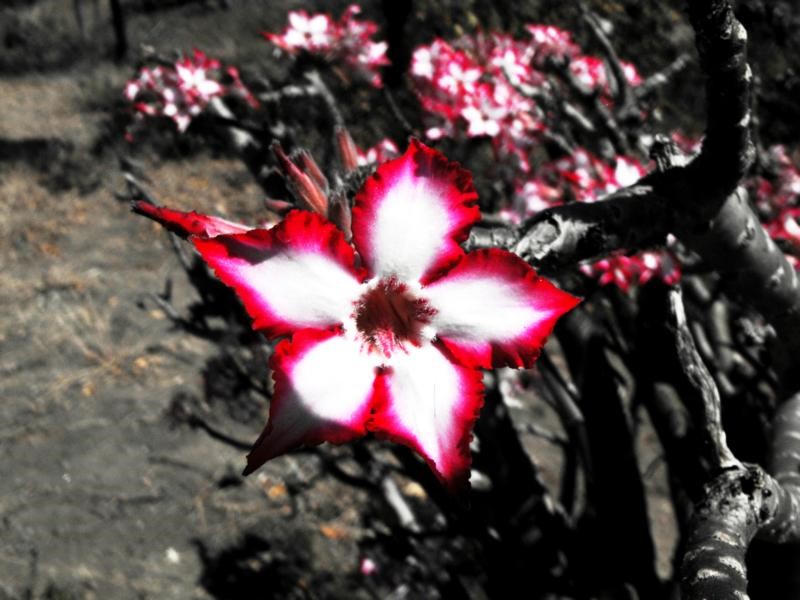Adenium multiflorum
By JP Felu
Family: Apocynaceae 
Botanical names: Adenium multiflorum (Adenium obesum var multiflorum)
Common names: Sabi Star, Impala Lily, Desert Rose, T: Mbwayumba, Sh: Chisvosve
Adenium multiflorum is, in Zimbabwe, a specially protected plant. One needs a special licence to cultivate, propagate or sell it. However, the status of hybrids in that respect is not clearly defined.
Some people may be surprised to find that Adenium multiflorum is classified as a tree. Unfortunately they are grazed by wild and domestic animals and they rarely have a chance to grow to their full stature.
Adenium multiflorum is a deciduous succulent shrub or small tree, growing from 0.5 to 3m tall. Its stems arise from a large underground rootstock. The family name, Apocynaceae, is Greek for “plant lethal to dogs” as some Apocynaceae contain a toxic milky sap.The bark of this particular species varies from shiny grey to brown, with a poisonous watery latex.
 For most of the year, the plants do not have flowers or leaves. The leaves are about 100 mm long, shiny green above and pale green below. They are carried in clusters at the growing tips of the branches and they are shed before flowering. The flowers are borne in terminal inflorescences, each flower 50 – 70mm in diameter. They vary greatly in colour, usually with pointed white lobes, crinkly red margins and red stripes in the throat. The flowers which bloom from May to September, are sweetly scented.
For most of the year, the plants do not have flowers or leaves. The leaves are about 100 mm long, shiny green above and pale green below. They are carried in clusters at the growing tips of the branches and they are shed before flowering. The flowers are borne in terminal inflorescences, each flower 50 – 70mm in diameter. They vary greatly in colour, usually with pointed white lobes, crinkly red margins and red stripes in the throat. The flowers which bloom from May to September, are sweetly scented.
The fruit appears as paired, two cylindrical follicles up to 240 mm long. The seeds are brown with a tuft of silky hairs. The pods are dehiscent and the tufts of hair at the ends of the seed help the seeds to roll on the ground like miniature axles.
Medicinal uses:
“The Traditional Medical Practitioner in Zimbabwe” mentions an infusion of the root to treat blood in the urine of cattle and diarrhoea and sore eyes in poultry. The use of Adenium as arrow poison is also reported from Senegal, Nigeria and Cameroon. A decoction of the bark and leaves is widely used as fish poison. This use is reported from Nigeria, Cameroon and East Africa. In Mauritania and Senegal, preparations from Adenium are used as ordeal poison and for criminal purposes.
In the Sahel, a decoction from the roots, alone, or in combination with other plants, is used to treat venereal diseases. A root or bark extract is used as a bath or lotion to treat skin diseases and to kill lice, while the latex is applied to decaying teeth and septic wounds. In Somalia, a root decoction as nose drops is prescribed for rhinitis. In northern Kenya, the latex is rubbed onto the head to treat lice and powdered stems are applied to kill skin parasites of camels and cattle. Interestingly enough the toxic nature of the plant does not deter baboons from digging the roots out and eating them.
Sources:
Find Me A Cure: Desert Rose. findmeacure.com/ 2009/11/18/desert-rose
Gelfand et.al. 1985. The Traditional Medical Practitioner in ZImbabwe. Mambo Press, Harare.
SANBI. www.plantzafrica.com
Wikipedia. Adenium multiflorum http://en.wikipedia.org.

